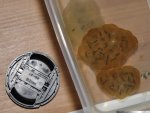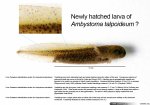- Joined
- Feb 6, 2001
- Messages
- 8,171
- Reaction score
- 437
- Points
- 83
- Age
- 47
- Location
- USA
- Country
- Ireland
- Display Name
- John Clare
Last week I received some eggs from South Carolina that were identified by the seller as Ambystoma talpoideum. He was quite helpful and told me that he is not an expert on salamanders but that he could tell these were distinctly different from Ambystoma maculatum eggs he found in the same area. Photo 1 is of these egg sacks. Petranka (based mainly on Semlitsch's papers) says that Atlantic Coast populations of A. talpoideum lay eggs singly, although I've found slightly contradictory notes in one of Semlitsch's papers. Also, Petranka states that two researchers identified some egg masses they found in South Carolina as being A. talpoideum, but Petranka says that these are "more than likely" A. tigrinum. The seller of the eggs believed there are only Spotted and Mole salamanders in the area where these were collected.
Photo 2 is a 1 day old hatchling from these eggs. I've included a scale and quotes from Petranka describing the hatchlings of the possible contenders (with the exception of A. tigrinum, which I think we can rule out).
Opinions? Any experts? Obviously I'd like them to be talpoideum but we don't always get what we want .
.
Just to clarify, the contenders are Ambystoma maculatum, Ambystoma talpoideum and Ambystoma mabeei. Descriptions from Petranka of the hatchling larvae of these three species are included in photo 2 (click it to enlarge to readable size). If your window is too small, the text in the larva photo may not be legible - in this case when you have clicked the thumbnail image to enlarge it, right click (on a PC) and select open in new window or new tab and it should help.
Photo 2 is a 1 day old hatchling from these eggs. I've included a scale and quotes from Petranka describing the hatchlings of the possible contenders (with the exception of A. tigrinum, which I think we can rule out).
Opinions? Any experts? Obviously I'd like them to be talpoideum but we don't always get what we want
Just to clarify, the contenders are Ambystoma maculatum, Ambystoma talpoideum and Ambystoma mabeei. Descriptions from Petranka of the hatchling larvae of these three species are included in photo 2 (click it to enlarge to readable size). If your window is too small, the text in the larva photo may not be legible - in this case when you have clicked the thumbnail image to enlarge it, right click (on a PC) and select open in new window or new tab and it should help.


